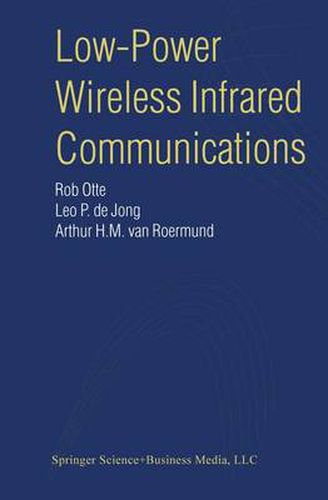Readings Newsletter
Become a Readings Member to make your shopping experience even easier.
Sign in or sign up for free!
You’re not far away from qualifying for FREE standard shipping within Australia
You’ve qualified for FREE standard shipping within Australia
The cart is loading…






This title is printed to order. This book may have been self-published. If so, we cannot guarantee the quality of the content. In the main most books will have gone through the editing process however some may not. We therefore suggest that you be aware of this before ordering this book. If in doubt check either the author or publisher’s details as we are unable to accept any returns unless they are faulty. Please contact us if you have any questions.
Today, wireless infrared transmission has entered our homes, offices, industry and health care, with applications in the field of remote control, telemetry and local communication. This text covers the underlying technology. As most equipment is battery-powered, the emphasis is on power optimization of the infrared transmission system. System parameters as well as environmental parameters that determine the eventual transmission quality are identified, to facilitate well-reasoned system design. Many design rules, based on calculations, measurements and simulations, are presented to help the designer push the performance close to the limits set by nature and the available technology. Firstly, the basic transmission link is introduced, and strategies to optimize its signal-to-noise ratio are discussed. Lighting flicker is identified as a possible source of interference. Then, receiver noise and bandwidth are discussed. It is argued that noise optimization and bandwidth optimization do not necessarily conflict. The following chapters provide the reader with an overview of modulation and synchronization techniques. Pulse position modulation is recognized as an attractive technique for low-power purposes. As receiver synchronization in those systems is a subject hardly covered by literature, an in-depth discussion of possible synchronization subsystems is included. This reference is for researchers and designers of infrared communication systems and those who are involved in standardization activities (Infrared Data Association, IrDA). For those who are new to the area, the first chapter serves as an introduction.
$9.00 standard shipping within Australia
FREE standard shipping within Australia for orders over $100.00
Express & International shipping calculated at checkout
This title is printed to order. This book may have been self-published. If so, we cannot guarantee the quality of the content. In the main most books will have gone through the editing process however some may not. We therefore suggest that you be aware of this before ordering this book. If in doubt check either the author or publisher’s details as we are unable to accept any returns unless they are faulty. Please contact us if you have any questions.
Today, wireless infrared transmission has entered our homes, offices, industry and health care, with applications in the field of remote control, telemetry and local communication. This text covers the underlying technology. As most equipment is battery-powered, the emphasis is on power optimization of the infrared transmission system. System parameters as well as environmental parameters that determine the eventual transmission quality are identified, to facilitate well-reasoned system design. Many design rules, based on calculations, measurements and simulations, are presented to help the designer push the performance close to the limits set by nature and the available technology. Firstly, the basic transmission link is introduced, and strategies to optimize its signal-to-noise ratio are discussed. Lighting flicker is identified as a possible source of interference. Then, receiver noise and bandwidth are discussed. It is argued that noise optimization and bandwidth optimization do not necessarily conflict. The following chapters provide the reader with an overview of modulation and synchronization techniques. Pulse position modulation is recognized as an attractive technique for low-power purposes. As receiver synchronization in those systems is a subject hardly covered by literature, an in-depth discussion of possible synchronization subsystems is included. This reference is for researchers and designers of infrared communication systems and those who are involved in standardization activities (Infrared Data Association, IrDA). For those who are new to the area, the first chapter serves as an introduction.